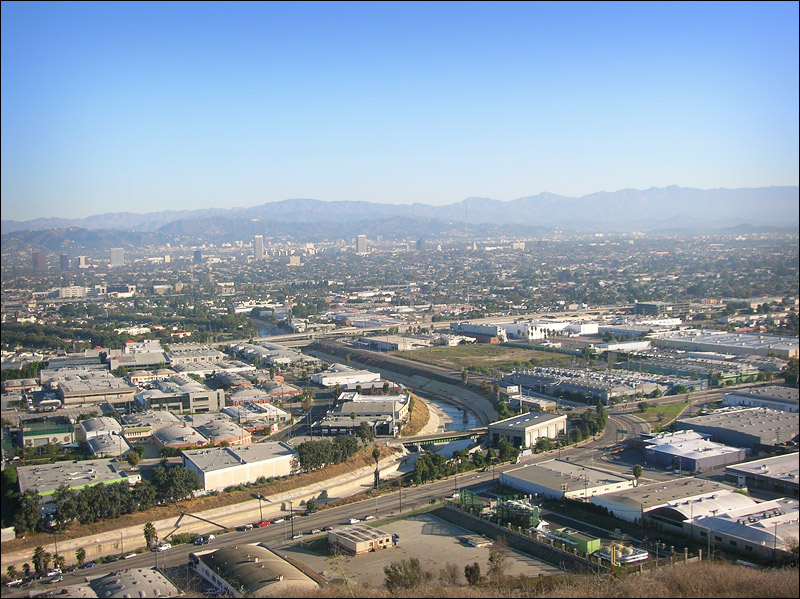And at Flying Pigeon I grouse about how hard it can be to lock a practical bike--one with basket, panniers, or saddlebag--to LA's standard sidewalk U racks: because It's Not About U.
Richard Risemberg on Wed, 30 Nov 2011 21:24:14 -0800 [link]
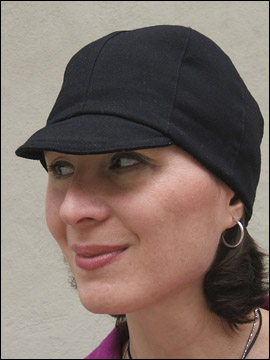 Doubly back, for the James Black Hat is back in black wool now. (Well, dark charcoal wool.) This is our beloved Three-Way Hat, that can be worn high and full over thick or curly hair, pulled down low to cover the ears, or with the back hem flipped up to fit like a classic cycling cap.
Doubly back, for the James Black Hat is back in black wool now. (Well, dark charcoal wool.) This is our beloved Three-Way Hat, that can be worn high and full over thick or curly hair, pulled down low to cover the ears, or with the back hem flipped up to fit like a classic cycling cap.Crafted in Los Angeles of fine, pure wool, it is also the ultimate take-everywhere hat: you can fold it into a pocket without ruining its shape, or making your pocket too bulky--and you can hand-wash it too!
Read all about it: the James Black Three-Way Hat!
Sizes L and XL, too.
Richard Risemberg on Tue, 29 Nov 2011 17:19:03 -0800 [link]
Today, however, we were condemned to visit the mall, as Gina's iPhone had met an untimely demise, and she needed to replace it in time for an important conference call.
Her sister, calling on the land line, fretted about the traffic and parking woes we would face, but she didn't know our little secret: bicycles, and a pleasant, nearly traffic-free route, mostly through an old but still progressive "Radiant City" type development between us and the mall that houses the Apple store.
Here's a little photo sequence showing you the highlights of our "daunting" expedition:
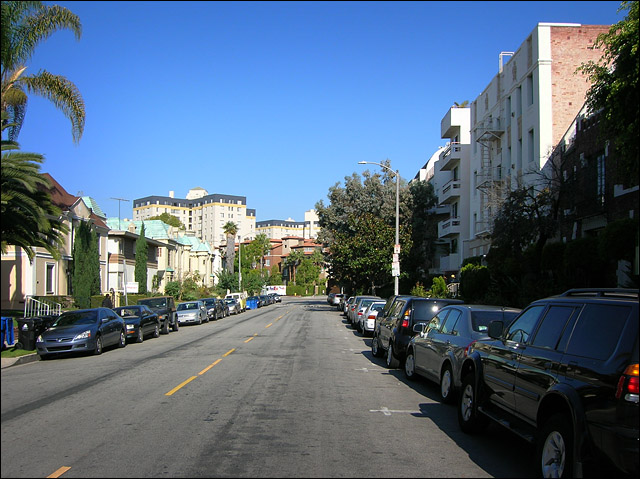
Our street, looking north
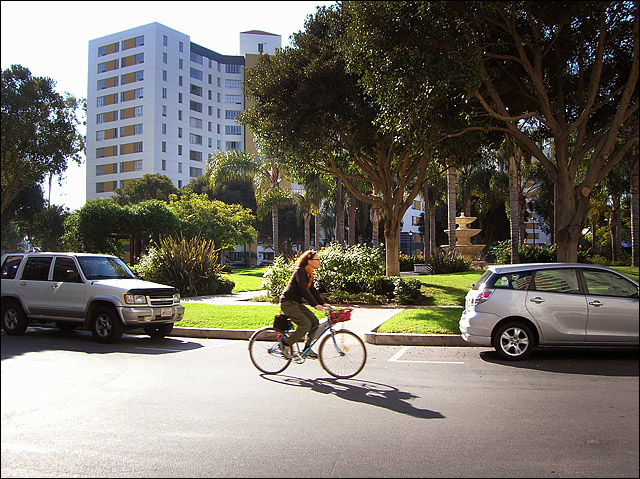
Gina swooping through the roundabout in Park La brea
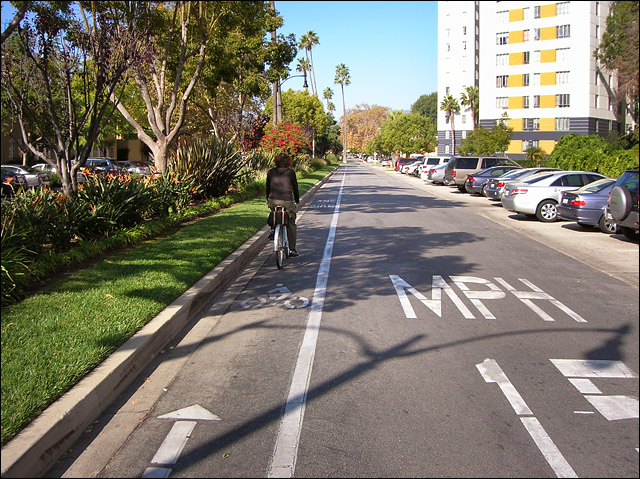
Taking it easy in the bike lane
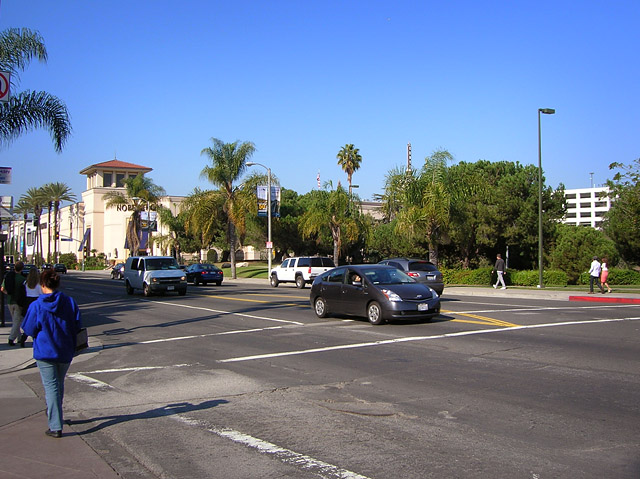
Back to public streets
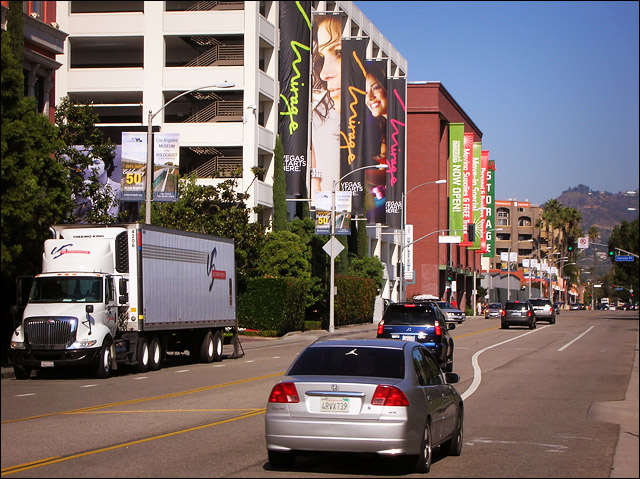
Approaching the giant parking garage
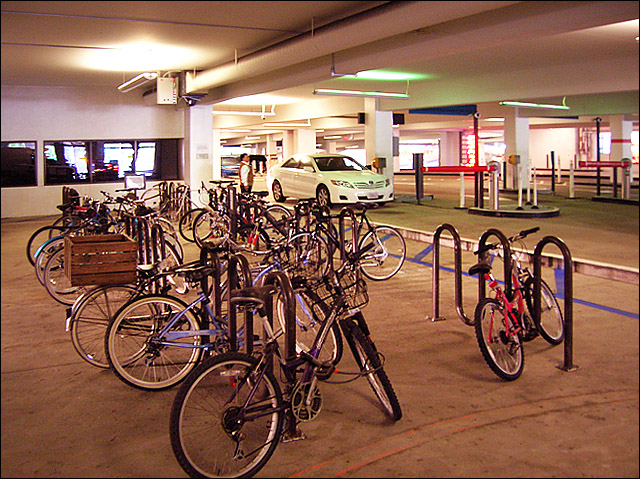
Which includes an extensive bike corral!
Of course, we did encounter traffic in the end--but at least it was pedestrian traffic....
Richard Risemberg on Fri, 25 Nov 2011 17:35:06 -0800 [link]
Meanwhile, Flying Pigeon gets a post on the City of LA's new LA/2B program, asking residents to help shape the city's transportation programs...and it's about damn time!
Richard Risemberg on Wed, 23 Nov 2011 12:59:24 -0800 [link]
I did have to wipe my face and glasses, as I'd faced a headwind the entire way out, but I had a truly beautiful ride home in what I call a "Mama Bear Rain"--not too hard, not too light.
When I left home with Gina to ride to the Farmers Market on Third for a spot of coffee, it was drizzling, and drizzle floats in the air and gets under my hat or helmet visor to land on my glasses.
When I left (with Gina staying behind to finish shopping for a magnificent six-course meal), it was raining hard, and the wind, as I said, blew the rain under the visor to, of course, land on my glasses.
But on the way home the rain was "just right"--large, gentle drops and little wind, so I rode the full nineteen miles back without a drop on my spectacles.
And let me tell you, that kind of rain riding is some of the best riding there is. The rainy day light is kind, even to an often rough and ragged city such as LA, and a hoe in the clouds in the far west let in the last light of the fading day. And of course the city actually smelled good!
It was a wonderful experience, much enhanced by my bike's fenders and sticky Schwalbe Marathon tires (designed for rainy Germany).
Not hard, not scary, not "epic," just a sweet ride through the city in the rain. Well worth the time.
It's interesting to note that the cities with the highest bicycle mode share in the US--San francisco, Portland, and Minneapolis--and elsewhere--Amsterdam, Copenhagen, Tokyo, Vienna, Beijing--are rainy or even snowy towns. There must be something behind those numbers...don't you think?
I did see a number of other riders out in the rain, as well as numerous bikes parked at stores and restaurants in East Hollywood, on my way out. LA growing up....
Richard Risemberg on Mon, 21 Nov 2011 09:01:34 -0800 [link]
Read it right here.
Richard Risemberg on Fri, 18 Nov 2011 15:07:41 -0800 [link]
Richard Risemberg on Thu, 17 Nov 2011 10:59:13 -0800 [link]
Then, to mix business and fellowship with the pure pleasure of a long ride, I wandered over to Santa Monica, where I knew my friend and fellow bicycle advocate Eric Weinstein would be holding court at the Farmers Market.
During our conversation we touched on the soon-to-open Bike Center that will occupy one small corner of the gigantic parking structure by Santa Monica Place, and Eric mentioned that bikestations never turn a profit, and so always need a subsidy.
Whether this is true or not as an absolute statement, I don't know, but I do know that this is a non-issue in this culture. Because public parking structures--and in fact roads themselves--never turn a profit either.
It's all subsidized! Just listen for the outcry when cities propose to sell off parking structures to for-profit private entities without including a subsidy to keep rates low. Market rate parking is expensive!
Roads and streets generally cover only 16% to 40% of their costs through "user fees" such as gas taxes. The rest is subsidy. Parking structures ditto. And in both cases providing excessive acreage of lanespace and parking carries an opportunity cost, as the land thus sequestered for private driving could be occupied by homes, businesses, or other more necessary public amenities such as schools.
So who cares if a bikestation requires a subsidy? If it induces more people to ride bikes instead of drive or take transit, it reduces what the city or county must spend to accommodate motoring!
Study after study now shows that skewing roads and parking towards cyclists results in more economic activity per dollar than pandering to motorists. (Let's not forget that motorists can become cyclists very easily.) Cars require big wide roads; cyclists don't. And you can park ten to fourteen bicycles in the space of one car. (Most cars run 3/4 empty, carrying only the driver and a few small items.)
The experiences of Portland, San Francisco, Minneapolis, and now even Austin show that accommodating cyclists is great for local businesses.
Alternatively, we can ask that if bikestations "need to be profitable," then so do public parking structures.
Richard Risemberg on Mon, 14 Nov 2011 07:23:33 -0800 [link]
(d) BICYCLE SAFETY. "The Secretary of the appropriate Federal land management agency shall prohibit the use of bicycles on each federally owned road that has a speed limit of 30 miles per hour or greater and an adjacent paved path for use by bicycles within 100 yards of the road."Read more at Cyclelicious. This page includes links to senate committee members who have a say on this bill.
This may be a "camel's nose" provision paving the way for further restrictions on cycling, and we must oppose it vigorously. I have already written Senator Boxer, one of the bill's sponsors and, incidentally, my representative, as follows:
Dear Senator Boxer:Read more about Complete Streets at the National Complete Streets Coalition.
Just noted the following in your bill:
(d) BICYCLE SAFETY."The Secretary of the appropriate Federal land management agency shall prohibit the use of bicycles on each federally owned road that has a speed limit of 30 miles per hour or greater and an adjacent paved path for use by bicycles within 100 yards of the road."
This is really pretty absurd. A bike path 300 feet to the side of a standard road (federally funded or not), may very well not lead to destinations bicycle users may want or need to access.
The answer is not throwing cyclists off to one side to make careless driving easier for motor vehicle operators, who are responsible for so much environmental and social degradation as well as death and maiming in our country; it is to design roads that safely accommodate all types of legitimate users, which certainly includes bicyclists.
Bicycles, after all, not only do not cause pollution; they measureably improve public health even when road crashes are factored in, and, because they do not require vast acreages of asphalt and the destruction of tax bases, relieve the public purse, which is in great need of relief lately. Institutionalizing prejudice against bicycle users will only further strengthen the stranglehold motoring has on our economy, our natural environment, and our civic culture, and, in national parks (site of many affected roads), would actually impede the enjoyment the populace can derive from their visits thereto. (You don't really see anything from within a car, and the space they require for roads and parking itself degrades natural areas, as well as cities.)
Would you ban cars from using any city streets that were within 100 yards of a freeway? Even if the freeway did not serve destinations commonly sought by motorists? That is the analogy to this provision.
Again, the answer is not banning bicycles but designing roadways intelligently so that all users can employ them safely. "Complete Streets" with which you really should be familiar if you're going to dip into transportation issues, should be your model, and I urge you to study and support H.R. 1780 & S. 1056, which would bring about true road safety without making unconsidered prejudices against a category of road users the law of the land. Please strike this (and any similar provisions) from this bill.
I have voted for you repeatedly for many, many years, but I am now reconsidering my support.
I do however look forward to what you have to say on this issue, as long as it isn't the usual boilerplate response one receives from one's representatives these days.
Richard Risemberg on Wed, 09 Nov 2011 18:32:10 -0800 [link]
At Orange 20 I give a roundup of new bike infrastructure developments in Santa Monica, just a few miles west, in Santa Monica Leads a Breakaway!
And I continue my harangue about rain riding at Flying Pigeon, where I become the Fender Defender.
Richard Risemberg on Wed, 09 Nov 2011 15:37:24 -0800 [link]
The other day I saw two bikes, belonging to fellow residents of our block, locked to a signpost in front of the building across the street. Parked in front of them, on the street, were two cars--SUVs in this case--also belonging to neighbors.
The contrast in spatial requirements was pretty striking:
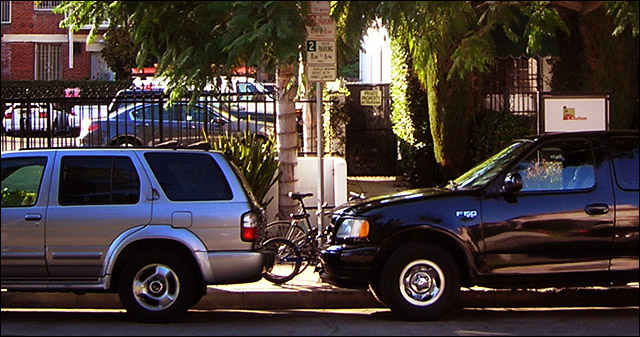
Today I went out with a tape and measured the actual square footage required for parking two personal vehicles:
- Two bikes: 4' x 8', totaling 32 square feet.
- Two cars, 8' x 40', totaling 320 square feet.
It's not just that this space needs to be built and maintained; there's an opportunity cost associated with it. If all streets were narrower--say, in a bicycle-oriented city such as (famously) Amsterdam, which still allows room for reasonable motor vehicle use--you would have more room for housing, civil amenities, schools, and businesses. This would result in a more active economy--more people working, dining, buying in a given area. Parked cars do not participate in the economy. This would also result in more sales tax and property tax returning to the city for a given area, meaning better schools, libraries, sanitation, possibly health care, and more--as well as better maintenance of remaining road space, a boon to drivers as well as cyclists.
Just sayin'. America's thralldom to the car costs us in health, time...and money.
We can do better.
Richard Risemberg on Wed, 09 Nov 2011 08:36:00 -0800 [link]
At Orange 20, I consider A Challenge, and Another Challenge, while over at Flying Pigeon, I wonder, Do You Always Need a Car for Cargo?
Richard Risemberg on Sun, 06 Nov 2011 07:09:31 -0800 [link]
And some, such as Santa Monica, use both, as you'll note in the photo of that city's Second Street below:
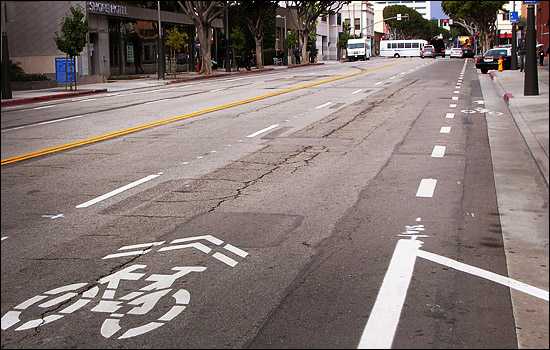
This is part of a burgeoning of new bicycle facilities in Santa Monica, which does see a great deal of bicycle traffic and obviously anticipates (and hopes for) more. Here it looks as though the inside car lane becomes an overflow lane for cyclists; it also firmly states that cyclists are not required to stay within the (rather narrow) bike lane.
For a while it seemed that all of Santa Monica's new bike amenities were going in on Main Street, but now the city has turned its attention back to its downtown.
This was photographed looking north from Second and Colorado, near the city's new (privately-operated) "Bike Center," set to open in a couple of weeks.
Richard Risemberg on Fri, 04 Nov 2011 15:21:01 -0800 [link]
There are plenty of scenic overlooks north of Mid-City--the Griffith Observatory, at least half a dozen turnouts along Mulholland Drive--and I visit them regularly. But for a long time there was no place south of Mid-City where you could stop and spend some time seeing the land, the streets, the buildings. This one opened recently, and though the road is a bit insane--I have no idea what, or whether, they were thinking when they cut it--it's doable, and there are even bike racks at the top...as well as at the bottom, for those who wish to hike up the pleasant-looking dirt trail.
I particularly enjoyed seeing Ballona Creek--the concrete channel in the middle of the photo--along which runs the Ballona Creek Bike Path, a sort of "bicycle freeway," complete with underpasses, that lets you get on about a mile upstream and ride nine miles to the beach without the slightest interference from motor traffic. There are plenty of access points at major streets, several neighborhoods, and one school as well. Unfortunately, the underpasses mean that this very handy road is closed on rainy days, when the creek level rises drastically, but during the ten dry months of the year this is a valuable crosstown route for cyclists, and plenty of folks do use it every day.
It connects Los Angeles, Culver City, West Los Angeles, the Marina del Rey, and Playa del Rey, and feeds into the Marvin Braude Bike Path that runs for well over twenty miles along the beach.
So, though it might not look like much in the photo, it means a lot to LA bike commuters.
And to me. I've seen where its main tributary springs out of a hillside in a canyon north of Hollywood, after which it flows underground for a while only to surface in a golf course west of Rossmore (and near where I grew up), dive underground again to cross Hancock Park, surface at Brookside, disappear again for a mile or two, then finally arise for the last time near Fairfax Avenue, shortly after which the bike path starts.
At tis seaward end it passes through (what's left of) the Ballona Wetlands, where herons, egrets, and other birds abound.
I've been riding it for at least twenty years now. Nice to see a different side of it at last.
Richard Risemberg on Tue, 01 Nov 2011 20:30:33 -0800 [link]



